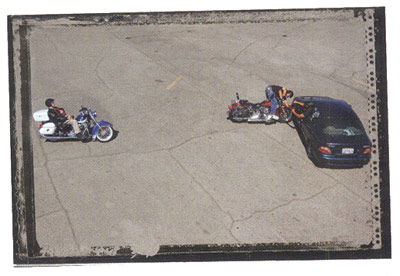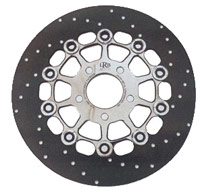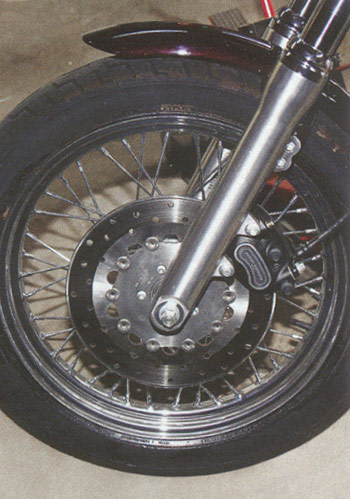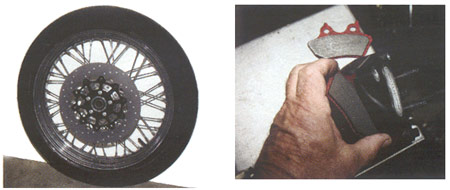 |
|
 |
 |
 |
- Baggers
Magazine - May, '08
- American
Iron Retailer - March-April,
'08 - Product Review
- American
Iron Retailer - March-April,
'08 - Showcase
- Drag
Specialties –
Magazine, Nov/Dec ‘07
- AMD
- August, '07 - Out
Braking the Competition
- Speed
- July, '07 - Tech Feature
- American
Bagger - August, '07
- Tech
- Barnett's
- July, '07
- V-Twin
- August, '07
- HOT
ROD's Bike Works, February,
'07
- HOT
BIKE - JULY, '06
- V-TWIN
- JUNE, '06
- THUNDER
PRESS - JUNE, '06
- THUNDER
PRESS - OCT, '05
- EASY
RIDERS MAGAZINE - OCT,
'04
|
|
| |
Barnett's
- July, '07> Product
Review
|
Metal
Matrix Composite Rotors
Lyndall
Racing Brakes LLC
800.400.9490
www.lyndallracingbrakes.com
By
Mark Barnett
Photography: Frank
Rangel |
| |
|
|
| So
another racing company trying
to muscle in on the Harley
crowd, eh? Well you better
be able to chrome it you
say. Now just hold on there,
let’s let this guy
give his schpiel and then
we’ll bolt them on
and try them, you can decide
then. Paul Kittrell working
out of Santa Ana, California
is offering metal composite
brake rotors and custom
pads to bolt right onto
your standard Harley models.
The rotors are light, a
little under two pounds
each with their aluminum
carriers and titanium buttons.
Stock rotors weight 4.7
lbs each, so you are removing
about 2.8 lbs of sprung
weight from each wheel if
you have a single disc set
up like the 2006 Harley-Davidson
FLST shown here. Just this
weight reduction I the wheel
area gives better steering,
better feeling over rough
roads and better braking.
Then comes Lyndall Racing’s
race-proven rotor design.
Made out of a metal matrix
of impregnated metal, it
offers, according to the
manufacturer, unparalleled
braking performance when
paired with their pads. |
| Lyndall
is not oblivious to the
Harley riders’ concern
with looks and also offers
pads to work with stock
Harley rotors plus their
own line of highly polished
stainless steel rotors for
those who need some flash.
If you choose to go with
the best stopping power
like we did, you order the
metal matrix discs. You
do get to pick the cut and
finish of the disc carriers.
You can look at all the
available designs and colors
at www.lyndallracingbrakes.com.
|
 |
| When
we got our discs in, the
lightness was very impressive,
but the proof was to be
in the stopping so we headed
out onto the greasy streets
of El Paso on the windiest
day of the year. Real world
testing on crappy roads
in dusty conditions. Admittedly,
I was starting to have second
thoughts, as it was my bike
the front and rear discs
were mounted on and any
slide outs or front end
tucks/bike dumping would
immediately result in a
new article, “How
to install new fenders and
a tank on a Harley Softail.”
Don’t laugh, this
was almost the case. I did
about six runs at 30 mph
and seven or eight at 50
mph for each set up, stock
and Lyndall, measuring all
the stopping distances.
I had three front end tucks
which resulted in the bars
turning left and quick aborts
on the runs. I was on the
brakes to point of locking
both the front and rear
each time. You could definitely
smell the rubber. I took
the best three stops for
the stock set up and for
the Lyndall Racing set up. |
| |
| The
results were pretty
impressive, almost
a 20% reduction in
stopping distance
at both 30 mph and
50 mph. That translates
to an 18 foot shorter
stopping distance
at 50mph, one full
car length. This was
due simply to materials
of the rotors and
pads. They worked
as advertised: light
weight with improved
friction. There were
no noises or any other
problems with the
Lyndall Racing Units.
And as an old ex-racer,
I liked the racy looks,
gave the bike a touch
of seriousness in
my opinion. High technology
and safety doesn’t
always come cheaply,
each rotor is $549
and a set of pads
is $59. But if you
are planning to build
in performance to
your custom ride,
don’t forget
the brakes. Nowadays
with distracted drivers,
that 18 feet could
come in super handy. |
 |
|
|
| |
V-Twin
- August, '07> Product Review
|
Metal
Composite Rotors: The
New Lite- Weight
Lyndall
Racing Brakes LLC
800.400.9490
www.lyndallracingbrakes.com
By
John Sullivan
Photography: John
Sullivan |
| |
|
|
There
was a time when using metal
to make something implied added
weight. With modern
technology, there are metal
composites these days that weight
next to nothing.
When
thinking about rotating motorcycle
wheels, lightweight is good.
So, along comes Lyndall Racing
Brakes with rotors made out
of the latest metal composites.
They are actually made from
two kinds of metal: the outer
disc is a metal composite; and
the inner hub is aircraft-grade
aluminum. The formulation that
is used for the friction disc
not only weights less, but it
dissipates heat better and resists
warping. The composite disc
is secured to the hub with aluminum
buttons that allow it to float
from side to side. The complete
rotor is less than half the
weight of a stock stainless
steel rotor.

Our starting point:
a 2006 Dyna Street Bob.
It has factory floating
rotors which weight
a couple of pounds each.
|
|
|
Lyndall
Racing Brakes Metal
Composite Rotors &
pads
|
LRB
offers 11½-inch rotors
for most 1984-up Harleys. For
our 2006 Street Bob we went
with rotors that had the hubs
finished in a black powder coating.
We also installed a set of their
Gold-series brake pads. The
installation was a straight
parts swap; everything fit like
the factory parts. The finished
biked stopped with two fingers
on the brake lever and looked
great doing it.
 |
| We
attached the
LRB composite
rotor using
the factory
Torx bolts,
putting some
No. 271 high-strength,
red Loc-Tite
on the threads. |
The
LRB Gold series
brakes pads
fit the stock
caliper. These
have a metallic
friction material.
They will also
work with factory
stainless steel
rotors. |
|
|
|
| Here
we see the finished installation.
The rotor's hub complements
the spoked wheel. |
|
|
|
|
|
 |
 |
|
| |
|
| |
|